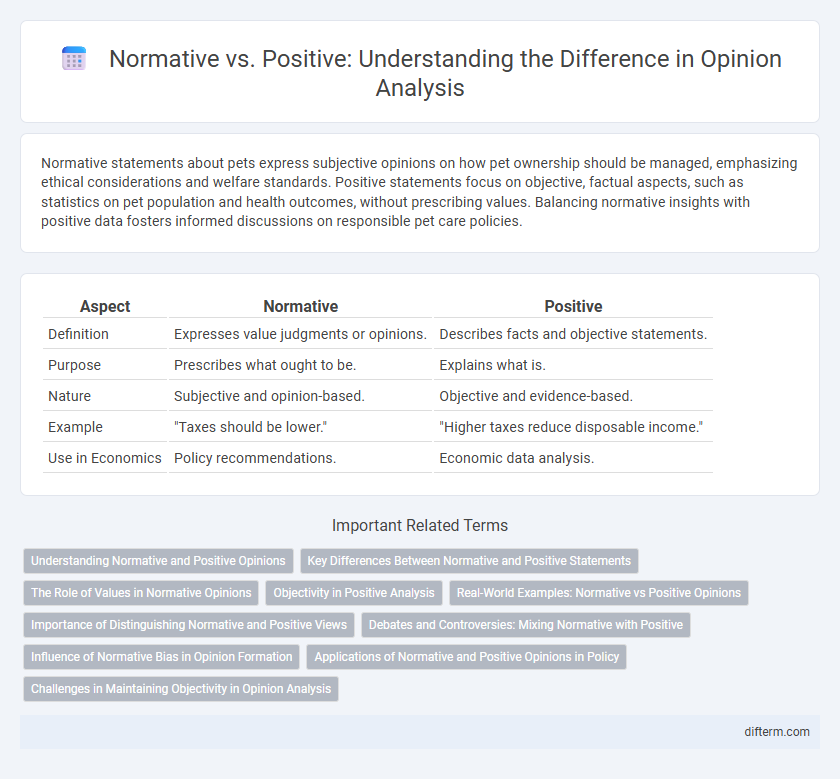Normative statements about pets express subjective opinions on how pet ownership should be managed, emphasizing ethical considerations and welfare standards. Positive statements focus on objective, factual aspects, such as statistics on pet population and health outcomes, without prescribing values. Balancing normative insights with positive data fosters informed discussions on responsible pet care policies.
Table of Comparison
| Aspect | Normative | Positive |
|---|---|---|
| Definition | Expresses value judgments or opinions. | Describes facts and objective statements. |
| Purpose | Prescribes what ought to be. | Explains what is. |
| Nature | Subjective and opinion-based. | Objective and evidence-based. |
| Example | "Taxes should be lower." | "Higher taxes reduce disposable income." |
| Use in Economics | Policy recommendations. | Economic data analysis. |
Understanding Normative and Positive Opinions
Normative opinions express value judgments about what ought to be, reflecting subjective beliefs and ethical standards. Positive opinions focus on objective analysis and factual statements describing what is, based on empirical evidence. Understanding the distinction helps clarify debates by separating emotional or moral perspectives from verifiable information.
Key Differences Between Normative and Positive Statements
Normative statements express value judgments and opinions about what ought to be, often reflecting ethical beliefs or societal goals, while positive statements are objective and fact-based, describing the world as it is without judgment. Positive statements can be tested and validated using empirical evidence, whereas normative statements rely on subjective perspectives and cannot be proven true or false universally. Understanding the distinction clarifies debates in economics and policy where facts are separated from value-laden opinions.
The Role of Values in Normative Opinions
Normative opinions are fundamentally shaped by values that define what ought to be, contrasting with positive opinions rooted in objective facts describing what is. Values guide the formation of normative judgments by embedding ethical, cultural, or personal principles, thereby influencing decision-making processes and policy preferences. Understanding this role of values clarifies why normative opinions often vary despite common empirical evidence, highlighting the subjective dimension of ethical reasoning.
Objectivity in Positive Analysis
Positive analysis emphasizes objectivity by relying on empirical evidence and testable hypotheses to describe how the world functions without value judgments. Unlike normative analysis, which incorporates subjective opinions and prescribes what ought to be, positive analysis strictly confines itself to factual statements and observable phenomena. This objectivity enables policymakers and researchers to evaluate outcomes based on data, enhancing clarity and reducing bias in economic and social studies.
Real-World Examples: Normative vs Positive Opinions
Real-world examples illustrate that normative opinions express subjective judgments about what should be, such as advocating for stricter environmental regulations to protect public health. Positive opinions, in contrast, are based on objective analysis and factual evidence, like reporting measurable reductions in pollution levels after policy implementation. Understanding the distinction between normative and positive opinions is essential for informed debates and effective decision-making.
Importance of Distinguishing Normative and Positive Views
Distinguishing normative from positive views is crucial to maintain analytical clarity in economics and social sciences. Normative statements embody value judgments about what ought to be, while positive statements describe observable facts and causal relationships without bias. Clear separation facilitates objective policy evaluation and informed decision-making by preventing conflation of subjective preferences with empirical evidence.
Debates and Controversies: Mixing Normative with Positive
Debates surrounding normative versus positive analysis highlight the challenges of mixing value-based judgments with objective facts, often leading to confusion in policy discussions. Critics argue that blending normative opinions with positive data blurs the distinction between what is and what ought to be, undermining empirical rigor. This controversy fuels ongoing disputes in economics and political science, where maintaining clear boundaries between descriptive statements and prescriptive recommendations is crucial for clarity.
Influence of Normative Bias in Opinion Formation
Normative bias significantly shapes opinion formation by prioritizing socially accepted norms over objective evidence, leading individuals to conform to group values rather than independent assessment. This bias often results in distorted perceptions and reinforces dominant ideologies, affecting both individual judgments and collective decision-making. Empirical studies reveal that normative influence can override factual information, highlighting the interplay between societal expectations and personal beliefs in shaping opinions.
Applications of Normative and Positive Opinions in Policy
Normative opinions guide policymakers by establishing value-based goals and ethical standards, shaping laws that reflect societal ideals. Positive opinions analyze empirical data and objective facts to predict policy outcomes and assess effectiveness without judgment. Combining normative and positive perspectives enhances comprehensive policy design, ensuring decisions are both principled and evidence-based.
Challenges in Maintaining Objectivity in Opinion Analysis
Maintaining objectivity in opinion analysis faces significant challenges due to the inherent subjectivity in interpreting normative statements, which express values and judgments, versus positive statements grounded in empirical facts. Analysts must navigate cognitive biases, selective exposure to information, and the influence of personal beliefs, which can skew data interpretation and compromise impartiality. Employing rigorous methodological frameworks and transparent criteria helps mitigate these challenges, ensuring more reliable differentiation between normative judgments and positive observations.
normative vs positive Infographic

 difterm.com
difterm.com